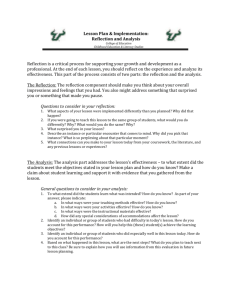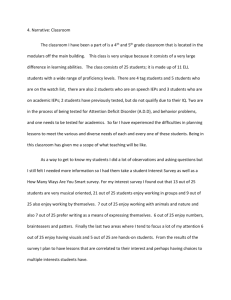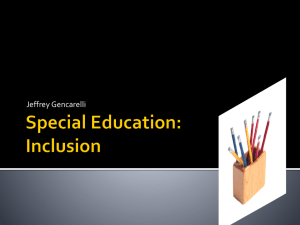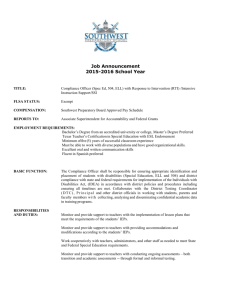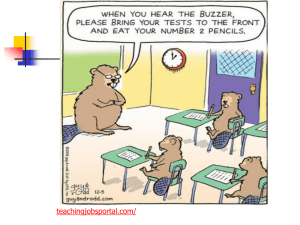School Improvement Plan - York Region District School Board
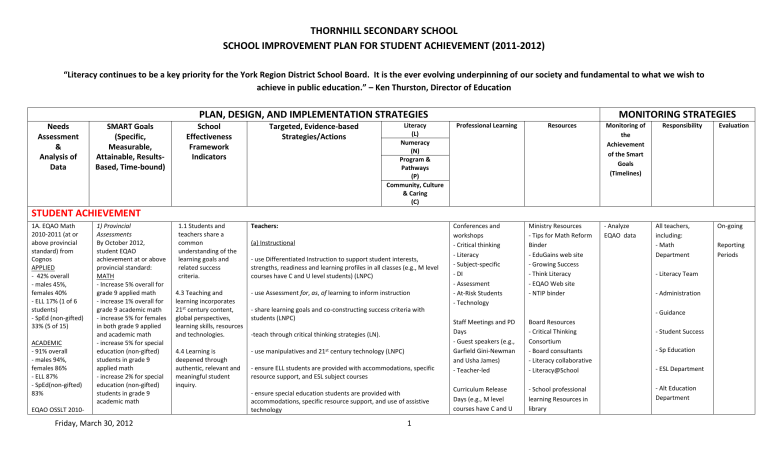
THORNHILL SECONDARY SCHOOL
SCHOOL IMPROVEMENT PLAN FOR STUDENT ACHIEVEMENT (2011-2012)
Needs
Assessment
&
Analysis of
Data
SMART Goals
(Specific,
Measurable,
Attainable, Results-
Based, Time-bound)
“Literacy continues to be a key priority for the York Region District School Board. It is the ever evolving underpinning of our society and fundamental to what we wish to achieve in public education.” – Ken Thurston, Director of Education
PLAN, DESIGN, AND IMPLEMENTATION STRATEGIES
School
Effectiveness
Framework
Indicators
Targeted, Evidence-based
Strategies/Actions
Literacy
(L)
Numeracy
(N)
Program &
Pathways
(P)
Community, Culture
& Caring
(C)
Professional Learning Resources
MONITORING STRATEGIES
Monitoring of Responsibility Evaluation the
Achievement of the Smart
Goals
(Timelines)
STUDENT ACHIEVEMENT
1A. EQAO Math
2010-2011 (at or above provincial standard) from
Cognos
APPLIED
- 42% overall
- males 45%, females 40%
- ELL 17% (1 of 6 students)
- SpEd (non-gifted)
33% (5 of 15)
ACADEMIC
- 91% overall
- males 94%, females 86%
- ELL 87%
- SpEd(non-gifted)
83%
EQAO OSSLT 2010-
1) Provincial
Assessments
By October 2012, student EQAO achievement at or above provincial standard:
MATH
- Increase 5% overall for grade 9 applied math
- increase 1% overall for grade 9 academic math
- increase 5% for females in both grade 9 applied and academic math
- increase 5% for special education (non-gifted) students in grade 9 applied math
- increase 2% for special education (non-gifted) students in grade 9 academic math
1.1 Students and teachers share a common understanding of the learning goals and related success criteria.
4.3 Teaching and learning incorporates
21 st century content, global perspectives, learning skills, resources and technologies.
4.4 Learning is deepened through authentic, relevant and meaningful student inquiry.
Teachers:
(a) Instructional
- use Differentiated Instruction to support student interests, strengths, readiness and learning profiles in all classes (e.g., M level courses have C and U level students) (LNPC)
- use Assessment for, as, of learning to inform instruction
- share learning goals and co-constructing success criteria with students (LNPC)
-teach through critical thinking strategies (LN).
- use manipulatives and 21 st century technology (LNPC)
- ensure ELL students are provided with accommodations, specific resource support, and ESL subject courses
- ensure special education students are provided with accommodations, specific resource support, and use of assistive technology
Conferences and workshops
- Critical thinking
- Literacy
- Subject-specific
- DI
- Assessment
- At-Risk Students
- Technology
Staff Meetings and PD
Days
- Guest speakers (e.g.,
Garfield Gini-Newman and Usha James)
- Teacher-led
Curriculum Release
Days (e.g., M level courses have C and U
Ministry Resources
- Tips for Math Reform
Binder
- EduGains web site
- Growing Success
- Think Literacy
- EQAO Web site
- NTIP binder
Board Resources
- Critical Thinking
Consortium
- Board consultants
- Literacy collaborative
- Literacy@School
- School professional learning Resources in library
- Analyze
EQAO data
All teachers, including:
- Math
Department
- Literacy Team
- Administration
- Guidance
- Student Success
- Sp Education
- ESL Department
- Alt Education
Department
On-going
Reporting
Periods
Friday, March 30, 2012 1
2011 (at or above provincial standard):
FIRST TIME ELIGIBLE
91% successful
- males 91%, females 92%
- ELL 38% (3 of 8 who wrote)
- SpEd(non-gifted)
88%
- Of the 3% deferred, 5 students are ELL, no SpEd
PREVIOUSLY
ELIGIBLE
46% successful
- males 57%,
females 58%
- ELL 75% (12 of 16 who wrote)
- SpEd(non-gifted)
25% (1 of 4)
- Of the 34% deferred more than once, 54% (19 of 35 students) are ELL, no SpEd
OSSLC (Credit
Course)
- 100% successful
- 20 males, 33 females
- 8 ELL
- 9 SpEd
OSSLT FIRST TIME
ELIGIBLE
- increase 1% overall
- increase 10% for ELL
(very small sample)
OSSLT PREVIOUSLY
ELIGIBLE
- increase 10% overall
- increase 10% for SpEd
(very small sample)
- teach students learning skills to enable them to take ownership of learning
(b) Pathways
- work collaboratively with elementary partner schools to develop shared responsibility for the academic progress and appropriate pathways as students transition to high school
- provide opportunities for credit accumulation through e-learning,
Personalized Alternative Education (incl. SAL), credit recovery programs, Cooperative Education, dual credits, OYAP, SHSM
- provide students with information on course pathways, postsecondary destinations, and career choices
(c) Community, Culture, and Caring Learning
- work collaboratively with elementary schools to develop shared responsibility for the social and emotional progress of students in the transition to high school
- increase communication with parents
School Leadership Teams:
(a) EQAO
- Analyze EQAO data
- Literacy teachers model literacy and critical thinking strategies to target grade 10 classes
- Literacy teachers model and support in-class teaching practices at staff meetings, PD days, and 1-1 support
- Literacy and math teachers communicate strategies and supports to teachers and parents
- Offer after school literacy and numeracy programmes
- Share literacy resources on school web site
(b) Credit Accumulation
2 level students)
Friday, March 30, 2012
- Critical Thinking
Team
(From Cognos)
Aug 31, 2011
Gr. 9: 94% (8+ credits)
Gr. 10: 92% (16+)
Gr. 11: 81% (24+)
Gr. 12 86% (30+)
Grd. 9: ELL 83%
Grd. 10: ELL 75%
Grd 11: ELL 69%
Grd 12: ELL 61%
Grd. 9: SPED %
Grd. 10: SPED %
Grd 11: SPED %
Grd 12: SPED %
SHSM 2011/12: 34 enrolled
Dual Credits: 2 students enrolled
January 2012
WELL-BEING
School Climate
Survey 2010
*Always/often
2) Credit Accumulation
By August 31 st , 2012 there will be a 2% increase in credit accumulation by students in Gr. 11 and 12 and we will maintain Gr.
9 and 10 credit accumulation levels, as measured by Cognos
Report
3) Student Engagement
By December 2012, students will be more engaged through
Friday, March 30, 2012
In addition to 1.1, 4.3,
4.4, 5.1
2.5 Staff, students and
In addition to 1.1, 4.3, and 4.4:
5.1 Programs, pathways, and career planning meet the learning needs and interests of all students.
5.3 Students, parents and teachers understand the full range of pathways, options, programs and supports that are available.
- ensure that Dept. Growth Plans and Annual Learning Plans reflect school improvement plan
Student Success Team identifies and monitors progress of at-risk students
-Hand timetabled schedules for ELL, SpEd and at-risk students
-implement strategic staffing to ensure all pathways are accessible
(e.g. workplace, college, university) LNPC
-liaise and support students, parents, school staff, elementary partner schools, and community in developing an understanding and respect for all programs and pathways options that are available to students. (PC)
-provide opportunities for students K-12, to learn about their personal strengths, interests and abilities and apply this knowledge in making appropriate decisions about educational and career opportunities (e.g. interest surveys, websites, Career Cruising,
Ontario Skills Passport). (LNPC)
See above
See above
Teachers:
- See Instructional Strategies Under Student Achievement
3
-Use technology for professional responsibilities to communicate (e.g.,
See above
-Analyze marks distribution report
See above See above
Analyze
School
Climate
All staff On-going
School
“This school has programs & activities that meet my needs and talents.”
64%
“I enjoy being at school.” 79%
“Staff at this school are willing to take suggestions from students.” 59%
“I find school work interesting.” 57%
*Always/often
“I feel safe at this school.” (86% strongly agree)
“Do you ever feel unwelcome or uncomfortable at your school” (51% sometimes/always)
“There is an adult at this school who I feel comfortable speaking to if I am bullied/harassed/bo thered” (54% strongly agree) personalized, collaborative and differentiated programming and learning as measured by
School Climate Survey
- increase each of the targeted questions by
5%
4) Safe, Supportive, and
Caring Schools
By December 2012, students will feel safer and more supported in an equitable, and inclusive environmental as measured by Student
School Climate Survey to support Positive
Climates for Learning
Initiative
- increase each of the targeted questions by
5% school community promote and sustain student well-being and positive student behaviour in a safe and healthy learning environment.
3.1 The teaching and learning environment is inclusive and reflects individual student strengths, needs and learning preferences.
2.5 Staff, students and school community promote and sustain student well-being and positive student behaviour in a safe and healthy learning environment.
3.1 The teaching and learning environment is inclusive and reflects individual student strengths, needs and learning preferences.
- give students voice as partners to their learning
-increase communication with parents
School Leadership Team:
- See strategies for Professional Learning activities under Plan,
Design, and Implementation Strategies
-give students and parents voice in the development of the school improvement plan
-ensure higher student representation in the next school climate survey
All Staff
Teachers:
- visible in the school
School Leadership Team
- support grade 8 students with transition to high school (e.g., Take
Our Kids to High School, grade 9 day, student mentors, prefects, elementary partner school visits by guidance, special education, ESL,
Empowering Student Partnership)
-increase communication with parents and school community as partners (e.g., School website, synervoice, Paw Prints, School Council,
Parents Night, e-mail)
- increase parent involvement to reflect the diversity of the school community (e.g., strategic hiring, use of community liaisons and settlement workers)
-promote anti-bullying awareness through Empowering Student
Partnerships, Gay-Straight Alliance club, liaison with School Resource
Officers
-use of Student progressive discipline and restorative approaches
-engage students in building environmental awareness as school seeks Eco-School certification
Moodle, Teach Assist,
Mark Book)
Board-initiated conferences (e.g.,
Crime stoppers) and workshops
PD day Safety
Compliance Day
Friday, March 30, 2012 4
Ministry resources
E,g., Inclusive and
Equity Strategy
Board resources
-Police protocol
Survey
Analyze
School
Climate
Survey
All staff
Climate
Survey
2012
On-going
School
Climate
Survey
2012

